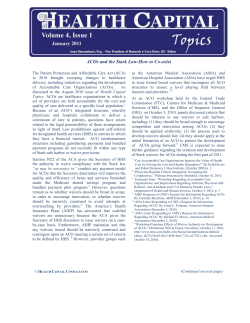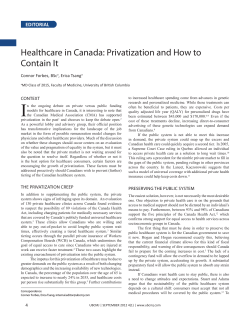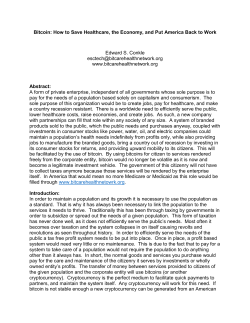
Determining Fair Market Value: When and How to Do-It-Yourself American Bar Association Health Law Section
Determining Fair Market Value: When and How to Do-It-Yourself American Bar Association Health Law Section Physicians Issues Interest Group Webinar Presented by: Albert “Chip” Hutzler, JD, MBA, CVA Partner, HealthCare Appraisers, Inc. November 21, 2013 1 Outline of Presentation • • • • • Need for Do‐It‐Yourself Appraisals Determining FMV for Healthcare Transactions When Do‐It‐Yourself Appraisals are Sufficient Best Practices for Do‐It‐Yourself Appraisals Additional Thoughts not in the eSource Article 2 Need for Do-It-Yourself Appraisals • Large volume of transactions subject to health law • “DHS” under the Stark Law includes: • All inpatient and outpatient hospital services • Most orders for drugs or medical devices • Most compliant transactions require FMV • 10 common Stark exceptions include an FMV requirement • (8 of those 10 also contain a “commercial reasonableness” requirement) • Other Stark exceptions require that the transaction “does not violate the Anti‐kickback statute” • OIG has indicated that lack of FMV can be evidence of bad intent for purposes of evaluating Anti‐kickback compliance. • 3 key OIG voluntary “safe harbors” require FMV and commercial reasonableness to be satisfied • IRS private benefit/private inurement guidance for non‐ profits • Requires that remuneration be FMV for needed goods and services 3 Determining FMV for Healthcare Transactions • Problems in Healthcare Valuation • Stark regulations suggest that “any reasonable method” is okay BUT • • • • • also that “traditional approaches” may not always be possible to utilize Data between parties in a position to refer cannot be utilized (does that leave anything?) Valuation of healthcare service arrangements is still a relatively new area within the valuation profession Many arrangements must also be commercially reasonable (different from FMV) Independent appraisals not required, but are preferred Some debate among lawyers and appraisers – e.g., intangible value • Practical Problems for Parties • Parties’ expectations are oftentimes difficult to counter • Rigorous, arm’s‐length negotiation may not result in a FMV outcome • Certain market data is simply not reliable 4 Determining FMV for Healthcare Transactions • Do‐It‐Yourself Valuations are Allowed: “We agree that there is no requirement that parties use an independent valuation consultant for any given arrangement when other appropriate valuation methods are available. However, while internally generated surveys can be appropriate as a method of establishing fair market value in some circumstances, due to their susceptibility to manipulation and absent independent verification, such surveys do not have strong evidentiary value and, therefore, may be subject to more intensive scrutiny than an independent survey” 66 Fed. Reg. 945 (January 4, 2001). 5 When DIY Appraisals are Sufficient • Avoiding Concerns of Government with Internal Valuations: • Bias, Manipulation • Rigor and Consistency • Relative Exposure to Healthcare Liability • Some otherwise simple transactions that are inherently riskier because they might suggest inducement by their very nature: • High dollar transactions • Transactions with large referral‐sources • DHS entities have higher liability risk • Because they file the DHS claims under Stark • False Claims Act risk also greater 6 Best Practices for DIY Valuations 1. 2. 3. 4. 5. 6. 7. 8. 9. Use a Consistent Method Use Multiple Valuation Approaches Use Multiple Objective Surveys Avoid Cherry Picking Survey Data Beware of Productivity Ratios in the Survey Data Beware of Anecdotal Data Beware of Strategic Value Avoid Valuations Based on “Opportunity Cost” Calculations Beware of Circular Databases • Data heavily influenced by one’s own transactions is dangerous 10. Avoid Success‐Based Rewards to Internal Valuators • Note: this is generally a requirement for reputable outside valuators, too 11. Consider Internal Valuation Frameworks • Extra protection gained if framework is reviewed by an outside valuator 7 Best Practices for DIY Valuations • Problems with Survey Data: • Surveys are voluntary – not random samples • Respondent pools vary widely (some groups not well • • • • represented) Limited regional and local data Limited data on benefits or other types of remuneration Cherry‐picking from surveys or tables within surveys Survey data can be misleading (e.g., physician productivity data) 8 Additional Thoughts (Not in the eSource Article) • Consider any “Stacking” concerns • Same provider paid separately for multiple different services • Stacked pay and services should be reviewed to ensure aggregate is FMV • Commercial Reasonableness should always be separately documented • Who is in best position to know if the transaction makes business sense? • Parties or Independent Appraisers (or both) • When are expected losses okay? • Practice Acquisitions – Danger in ignoring post‐transaction compensation • Key to consider acquisition and post‐transaction compensation together – separate valuations dangerous, due to risk of double payment. • Understanding Fee‐for‐Service Reimbursement Important • Split of “professional” and “technical” components impacts certain valuations • • • • How to value quality metrics (fee‐for‐services vs. value based payments) How to value management services How to value intangible assets (is DIY okay?) How often should DIY valuations be done? 9 Additional Thoughts (Not in the eSource Article) • Commercial Reasonableness • Not officially defined in Stark, but commentary defines it • Key question : Would the parties do this deal if there were no federal program referrals? • Examples of commercially unreasonable • • • • Too many medical directors No chance to earn a profit – is this okay? Paying for early termination rights Overbroad non‐compete 10 Additional Thoughts (Not in the eSource Article) A Final Important Thought: • FMV cannot save transactions with bad intent • Internal valuation may successfully determine FMV, without consideration of the volume or value of referrals, BUT • The parties cannot transact (even at FMV compensation) if any purpose of the payment is to compensate for past referrals or secure new referrals (one‐purpose test) • Example ‐ United Shockwave Settlement • Physician Group was the target (not the hospital) 11 Questions? Albert “Chip” Hutzler, JD, MBA, CVA Partner HealthCare Appraisers, Inc. chutzler@hcfmv.com (561) 330‐3488 12
© Copyright 2025





















